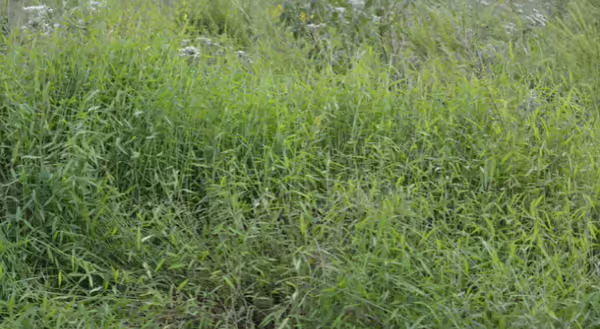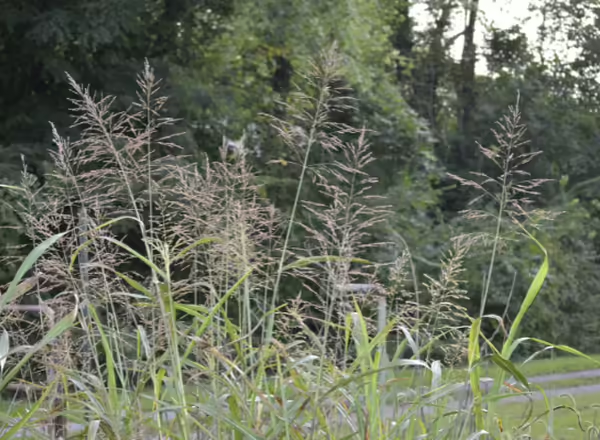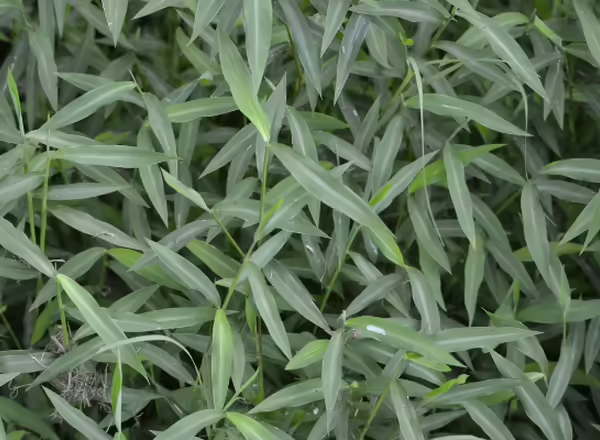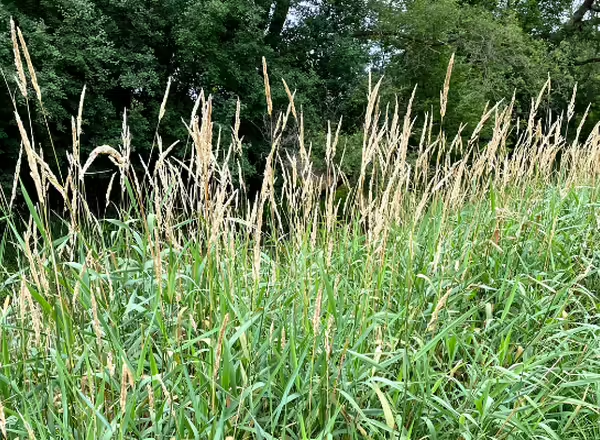
One of the reasons plant identification is so important is to help us tell the difference between plants that contribute to a healthy ecosystem and those that interrupt those interactions. Certain plants are exceptionally good at causing problems for natural communities, and require intervention and treatment to eradicate them. Invasive plants are those that were (1) introduced to an area they were not found historically, whether intentionally or unintentionally, and are not part of our native ecosystems; (2) establish and spread aggressively in these new areas; and (3) cause economic or ecological damage. What grasses are invasive in Illinois? Let’s take a look at three of them – Johnson Grass, Japanese Stiltgrass, and Reed Canary Grass.

This grass is in full bloom right now, making identification much easier. Johnson Grass is warm season grass that is found in disturbed areas, especially along roadsides. Its current reported distribution is focused in the southern half of Illinois, but it is found in quite a few northern and central counties as well. View its current distribution on EDDMapS.
This grass spreads through rhizomes, making eradication difficult. It grows 4 to 7 feet tall, and it’s stems are thick and often glaucous, which means they produce a white substance that works like a sunscreen, and can be wiped off the stems. Its leaves are several feet long and broad, with a prominent white midrib. Its ligule is made up of velvety hairs.
It blooms in the summer, producing a panicle that can be over a foot tall. Its reddish colored spikelets, some of which have awns, can be found along branches.

Japanese Stiltgrass is an invasive, warm-season annual grass. It can be found in shady, moist environments, such as the understory of forests and along waterways, but can also establish in sunnier and drier areas. This grass has a long period of development – it starts to grow in early spring, but waits until late summer or early fall to flower. It is a weak stemmed grass with short, broad leaves that taper at their base and tip. They have a silvery midrib that is slightly off center and hairs near the leaf base. In the winter, the foliage turns a straw color.
Its flower are discreet and easy to miss. It produces a raceme inflorescence with fingerlike collections of spikelets.
This one is actively spreading so be on the lookout, and report it if you find it! View its current distribution on EDDMapS. Read more about Japanese Stiltgrass on the Naturalist News blog.

This grass is a cool-season grass, flowering in late spring to early summer. It can be found in nearly every county in Illinois. View its current distribution on EDDMapS. This grass prefers wetter areas like wetlands, marshes, and wet prairies. It grows between 3 and 5 feet tall, and its leaves and stems have a gray-green hue. This grass has a tall, membranous ligule.
It has a narrow panicle inflorescence, which means before it is fully opened, it can look like a spike. It is densely packed with small, pointed spikelets. The spikelets turn a golden color when they senesce.
Learn more
Are you looking to learn more about invasive species in general? We are building a new website at extension.illinois.edu/invasives. Check back for updates as we add additional species and resources. If you want to report a sighting of an invasive species, you can use EDDMapS at www.eddmaps.org.
If you happen to have one of these species on your property, use the Management of Invasive Plants and Pests of Illinois guide to help you make management decisions.
Never miss a new post! Sign up for our email list.
ABOUT THE AUTHOR: Erin Garrett is a Natural Resources, Environment, and Energy Educator for University of Illinois Extension serving Alexander, Johnson, Massac, Pulaski, and Union counties. Erin develops and delivers high impact programming to adults and youth to help them develop an appreciation for natural resources and to empower them to make small changes to positively impact the environment. Erin’s programming focuses on why homeowners should consider choosing native plants, how to support native pollinators, how to identify grasses, how to identify and manage invasive species, and developing an appreciation for prairie ecosystems.
ABOUT THE BLOG: Grasses at a Glance dives into grass identification, focusing on tips and tricks that make grass identification possible. Get information about native and non-native species, how to tell look-alikes apart, and which grasses you can find in Illinois.